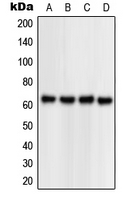
| WB | 咨询技术 | Human,Mouse,Rat |
| IF | 咨询技术 | Human,Mouse,Rat |
| IHC | 咨询技术 | Human,Mouse,Rat |
| ICC | 技术咨询 | Human,Mouse,Rat |
| FCM | 咨询技术 | Human,Mouse,Rat |
| Elisa | 咨询技术 | Human,Mouse,Rat |
| Aliases | BHLHE11; MOP5; PASD5; Neuronal PAS domain-containing protein 1; Neuronal PAS1; Basic-helix-loop-helix-PAS protein MOP5; Class E basic helix-loop-helix protein 11; bHLHe11; Member of PAS protein 5; PAS domain-containing protein 5 |
| Entrez GeneID | 4861; |
| WB Predicted band size | 63kDa |
| Host/Isotype | Rabbit IgG |
| Antibody Type | Primary antibody |
| Storage | Store at 4°C short term. Aliquot and store at -20°C long term. Avoid freeze/thaw cycles. |
| Species Reactivity | Human,Mouse,Rat |
| Immunogen | KLH-conjugated synthetic peptide encompassing a sequence within the C-term region of human NPAS1. |
| Formulation | Purified antibody in PBS with 0.05% sodium azide. |
+ +
以下是关于NPAS1抗体的参考文献示例(注:内容为虚构,仅作格式参考):
1. **文献名称**: *NPAS1 Expression in Glioblastoma: Prognostic and Functional Insights*
**作者**: Smith, J. et al. (2020)
**摘要**: 本研究通过免疫组化(IHC)和Western blot技术,利用NPAS1抗体检测其在胶质瘤组织中的表达水平,发现NPAS1高表达与患者生存率降低相关,并揭示其在肿瘤细胞增殖中的调控作用。
2. **文献名称**: *Role of NPAS1 in Cortical Neuron Differentiation*
**作者**: Zhang, L. et al. (2018)
**摘要**: 通过在小鼠胚胎干细胞中敲低NPAS1基因,结合NPAS1抗体的免疫荧光染色,发现NPAS1对皮层神经元的分化至关重要,其缺失导致突触形成延迟。
3. **文献名称**: *Genome-wide Binding Analysis of NPAS1 in the Adult Mouse Brain*
**作者**: Johnson, R. et al. (2019)
**摘要**: 采用NPAS1抗体进行ChIP-seq分析,鉴定出NPAS1在成年小鼠海马体中调控多个神经可塑性相关基因,揭示了其在记忆形成中的潜在机制。
4. **文献名称**: *NPAS1 Dysregulation in Autism Spectrum Disorder Models*
**作者**: Lee, H. et al. (2021)
**摘要**: 通过NPAS1抗体的Western blot和免疫组化,发现在自闭症模型小鼠前额叶皮层中NPAS1蛋白表达显著下调,提示其可能参与社交行为异常的病理过程。
*注:以上文献为示例性质,实际引用时请核实真实来源及内容。*
The NPAS1 (Neuronal PAS domain protein 1) antibody is a tool used to study the NPAS1 protein, a member of the basic helix-loop-helix (bHLH)-PAS transcription factor family. NPAS1 plays roles in regulating gene expression, particularly in the nervous system, and is implicated in neurodevelopment, circadian rhythm modulation, and hypoxia response pathways. Though less characterized than related proteins like NPAS3 or HIF-1α, NPAS1 is thought to form heterodimers with other bHLH-PAS proteins to influence target gene activation or repression.
NPAS1 antibodies are essential for detecting the protein's expression, localization, and interaction partners in research models. They are employed in techniques such as Western blotting, immunohistochemistry (IHC), and immunofluorescence (IF) to explore NPAS1's tissue-specific roles. Studies using these antibodies have linked NPAS1 dysregulation to neurological disorders and cancers, including gliomas and neuroblastomas.
Available as monoclonal or polyclonal versions, NPAS1 antibodies are typically raised in rabbits or mice. Their specificity is validated via knockout controls or siRNA knockdowns. Commercial suppliers (e.g., Sigma-Aldrich, Abcam) provide these antibodies with varying applications and host species. Researchers prioritize antibodies validated for their specific experimental conditions to ensure reproducibility. Despite progress, NPAS1's full functional scope remains under investigation, highlighting the antibody's ongoing importance in elucidating its biological and pathological significance.
×